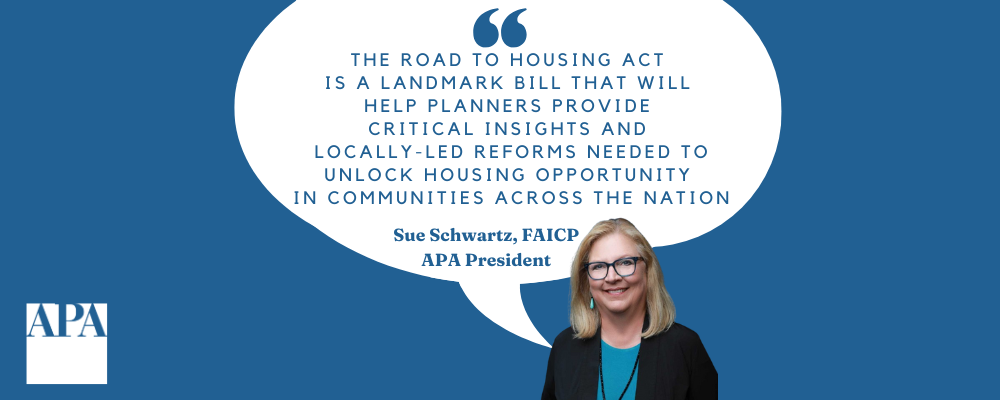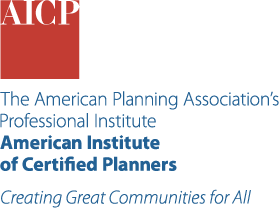Federal Impacts
'ROAD to Housing' is Paved by Planning
The ROAD to Housing Act is the biggest housing package in a generation, made possible through bipartisan compromise and support for local reforms.

UPDATE: As of October, 9, 2025, the Senate passed the National Defense Authorization Act (NDAA) by a vote of 77-20, which included the ROAD to Housing Act of 2025. The House passed their version of NDAA not including the ROAD to Housing Act. APA will be urging the conference committee to include ROAD in the final version of the NDAA bill.
The Senate Banking Committee's passage of the Renewing Opportunities in the American Dream (ROAD) to Housing Act marks an important victory in bipartisan action on housing. Though the landmark bill has yet to reach the Senate floor for a final vote, the unanimous support across the aisle — led by Senate Banking Committee Chair Tim Scott (R-SC) on the right and Senator Elizabeth Warren (D-Mass.) on the left — is further evidence that housing is an issue that has true bipartisan support to address.
We're taking a leap in the right direction in a bipartisan fashion. Many people around the country who are frustrated with the way we do American politics wonder, is there any issue that brings this nation together, and I'm here to say, hallelujah! We have found one — it is housing.
— Chairman Tim Scott
The role of land use and zoning reforms is centered in the ROAD to Housing bill, signaling a growing acknowledgement that federal support for local planning is key to tackling the nation's housing crisis. The programs and legislation included in the package provide planners with access to critical support, incentives, data, and best practices, enabling the tailoring of reforms to suit the needs of communities nationwide.

The American Planning Association joins a broad cross-industry coalition voicing support for the ROAD to Housing legislation.
What's in the bill
The ROAD to Housing incorporated provisions from several bills that APA had previously endorsed. In addition, it also incorporated a number of valuable provisions related to housing finance and strengthening federal programs.
The ROAD to Housing bill includes:
- The Housing Supply Frameworks Act, an APA-endorsed bill that will provide planners with access to national data, policy models, research support, and best practice frameworks from the Department of Housing and Urban Development (HUD) to leverage at the local level.
- The Accelerating Home Building Act, an APA-endorsed bill that will provide funding for communities to implement pre-approved plans — a method proven to help advance housing supply by streamlining the approval process for projects in alignment with a designated plan.
Increasing Housing Supply Through Reform

Utilizing Pre-Approved Plans and Other Housing Strategies
Learn more about pre-approved plans and other strategies for increasing housing supply in communities like yours in the Housing Supply Accelerator Playbook.
- The APA-endorsed Build More Housing Near Transit Act, which incentivizes pro-housing policy near public transportation routes and prioritizes transit-oriented development in the evaluation of federal transit grants
- Elimination of the chassis rule and inclusion of the PRICE Act, which together will reduce restrictions to building modular and manufactured housing, and provide grants to communities to maintain and stabilize manufactured housing
- Targeted housing exemptions for environmental reviews, which will speed housing production
- An Innovation Fund authorizing a 5-year grant competitive program to support localities advancing zoning reform (formerly known as the PRO Housing program)
- The RESIDE Act, which creates a pilot discretionary program to support commercial conversions and transform vacant and abandoned buildings into attainable housing
- Reauthorization of and updates to the HOME Investment Partnerships Program, which will facilitate the construction of more affordable housing
- A variety of financial components aimed at speeding development of missing-middle housing, such as a provision that makes it easier to receive a loan for ADU construction. Together, these components would help improve housing finance to support greater housing choice.
Finance Tools for Housing Abundance
Taking inventory of all allowable financial tools and programs available is the first step in developing a funding strategy that supports the production, preservation, and improvement of the local housing supply.
Here are four tips to explore the wide variety of financial tools available, and a look at how some communities are already using these tips to their advantage.
- Reforms to the Rural Housing Service and Rural Housing Act, which would help preserve affordable housing in rural areas and direct HUD and USDA to coordinate on joint environmental reviews for housing funded by both agencies.
- A pilot program that would build a new targeted incentive into the Community Development Block Grant program (CDBG). The new approach maintains the current formula for grants but adds a formula to encourage local action on housing supply. Some jurisdictions with above-median housing costs and below-median housing growth rates would forfeit 10 percent of their CDGB funds. That money would then be redistributed to jurisdictions with above-median housing costs and above-median rates of growth. The minimum threshold for units will depend on the size of the community and the region in which it is located.
The 'ROAD' Ahead
Supporters are pushing for a floor vote in the Senate following the upcoming August recess. The loud bipartisan support for the ROAD to Housing in the Senate bodes well for many of the key elements of the bill to make it across the finish line to a final vote.
While there is not yet a House companion to ROAD to Housing, many of its provisions are included in a variety of House bills that also have bipartisan support, and leaders on the House Financial Services Committee appear eager for action.
The success of this legislation demonstrates that federal action on housing is possible, and with resounding bipartisan support. At a time of extreme polarization, Republicans and Democrats on the Banking Committee found common ground to introduce legislation that would dramatically improve the relationship between federal and local government on housing — leveraging federal fiscal, policy, and research support to allow local reform decisions that boost housing supply.
This relationship model would allow planners to take center stage in leading reforms in their communities, implement innovative solutions, and put federal resources to use for maximum impact at the local level. APA and planning advocates will continue working to secure federal recognition and support for the planning that is necessary to create housing solutions.
For years, the American people have called on their elected officials to act to reduce housing costs. The Scott-Warren legislation represents what is possible when both parties put families ahead of politics. It's a significant step in the right direction. I'm happy today, but this is only a first step. Congress must do more. I look forward to continuing to work on these issues.
— Ranking Member Elizabeth Warren
Planners Speak Out for Federal Action on Housing
Legislation like the ROAD to Housing is possible thanks to the consistent work of planning advocates consistent work advocating for federal support that empowers localities to make changes to outdated regulations.
Stay up to date on the latest federal housing action by joining the Planners' Advocacy Network, a direct-to-your-inbox newsletter on what planners need to know is happening on the Hill.
Top image: iStock / Getty Images Plus – benedek
ABOUT THE AUTHOR


